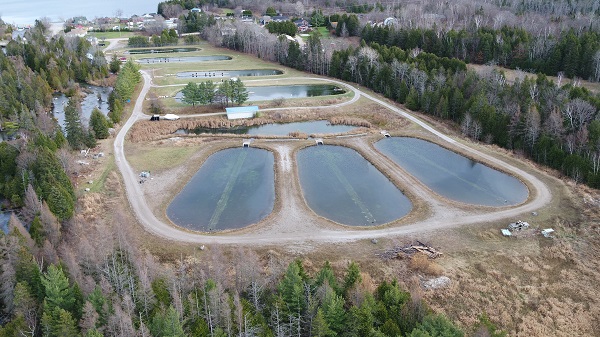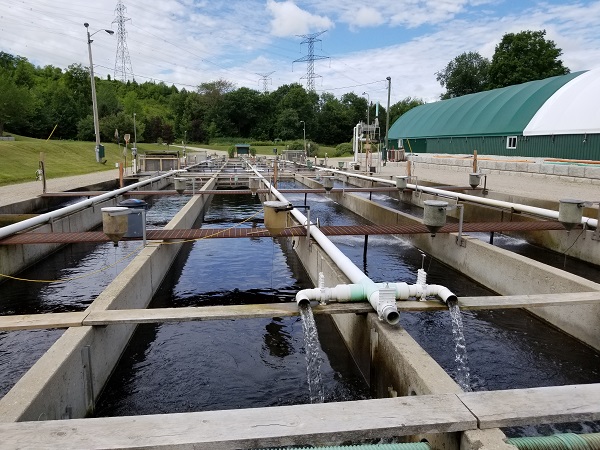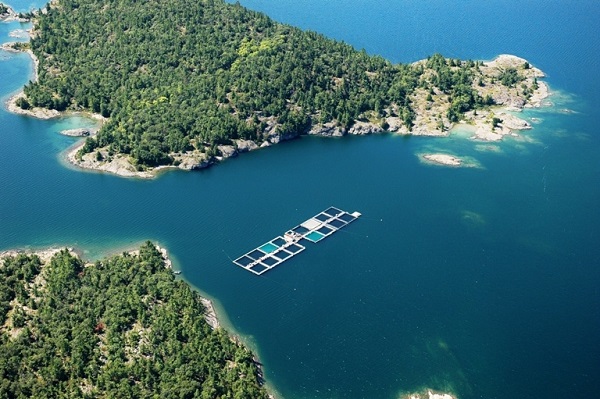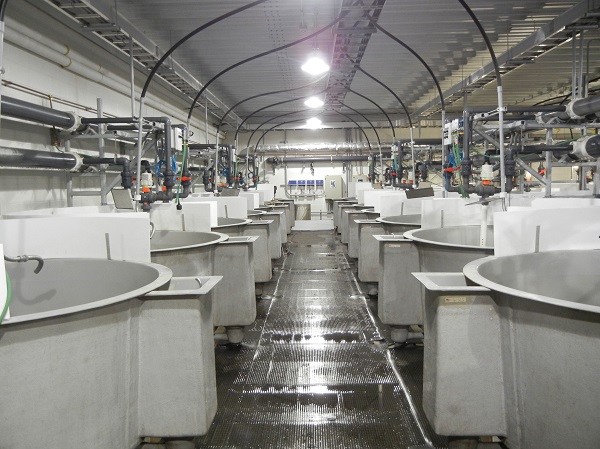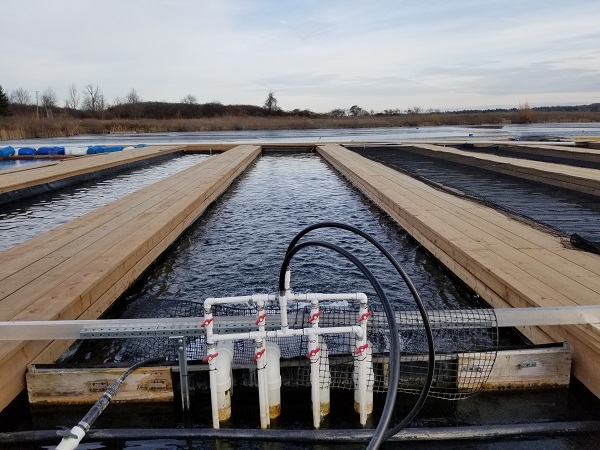Aquaculture production systems
Information on the 5 different types of aquaculture production systems used to farm fish in Ontario.
ISSN 1198-712X, Published March 2025
Introduction
There are 5 different types of aquaculture production systems used in Ontario to farm fish:
- ponds
- land-based flow-through
- open water net-pens
- recirculating aquaculture systems (RAS)
- closed containment floating raceways
This fact sheet provides information about each type including design, advantages, disadvantages and species cultured in Ontario.
Ponds
Ponds (Figure 1) are one of the most common aquaculture production systems used worldwide to grow fish, crustaceans and aquatic plants. Pond aquaculture ranges in size from large-scale commercial operations to small-scale subsistence farming.[3] They can be artificially constructed with a rectangular shape and steep sloping sides or can be natural in origin. Fish roam free throughout the pond and are handled for stock management activities using a seine net. Feeding may include foraging from the natural environment, a commercial pelleted diet or a combination of both. Pond aquaculture is characterized by low stocking density, high labour costs and little to no control over water temperature.[2] Predation can pose a significant problem in pond aquaculture, and preventive measures are typically required to eliminate or mitigate stock losses.
Ponds were a popular aquaculture production system used by Ontario commercial fish farmers in the 1960s to grow rainbow trout. They fell out of favour with Ontario aquaculture producers who, by the 1970s, were opting for more intensive production systems such as land-based raceways. Ontario’s cold climate makes pond aquaculture challenging because the growing season is short and only species that can tolerate a wide range of water temperatures can be successfully cultured. In some cases, the low capital costs associated with pond aquaculture make it popular among Ontario hobby-farmers, baitfish producers and fee-fishing operators.[2] Some species that are suitable for pond aquaculture in Ontario include perch, walleye, rainbow trout, bass, koi and baitfish.[2]
Land-based flow-through
Flow-through aquaculture systems (Figure 2) use raceways and circular tanks to grow fish on land. The rearing unit is usually constructed of concrete or fiberglass, is shallow and relies on a high volume of water flow to provide optimal water quality and oxygen for fish.
In a flow-through system, water passes through the rearing unit once and is discharged without recirculation. In some instances, raceways can be used in series where out-flow water from one raceway cascades into another unit at a lower elevation. Flow-through systems allow for high stocking density, improved feeding efficiency and access to fish for stock management. They require large volumes of high-quality freshwater, which can limit the availability of suitable sites. Species used in flow-through systems should be tolerant of high stocking density and a wide range of year‑round water temperatures. Optimal productivity is achieved when inflow water temperature closely matches the ideal water temperature for the targeted species.[2],[3]
In Ontario, flow-through aquaculture systems became popular in the mid 1970s for the culture of salmonid species including trout, char and salmon. At the time, flow-through systems were used for all stages of salmonid production. As open water net-pen aquaculture in Ontario gained popularity in the 1990s, the primary focus of flow-through farms shifted toward broodstock and fingerling production to support net pen grow-out sites. Today, most rainbow trout produced in Ontario’s open-water net pens spend the first 6–9 months of their lives at land-based flow-through farms.[2]
Open water net pens
Open water net-pen or cage aquaculture systems (Figure 3) are floating structures constructed of steel or plastic (for example, HDPE) from which a net is suspended creating an enclosure to contain fish. They are moored in sheltered areas of lakes, rivers and oceans to avoid adverse weather conditions. Open water net-pen aquaculture is the primary mode of aquaculture production in Ontario and accounts for most of all production in the province.[1]
Proper siting is essential to the success of these production systems, particularly for ensuring appropriate water temperature and quality. Open water net-pens rely on sufficient water circulation to provide an open exchange of oxygen-rich water throughout the rearing unit to support fish growth. Fish in net-pens are fed a nutritionally balanced pelleted diet as the natural environment most often provides no food for the cultured species. Species cultured in net-pens are often high-value species such as Atlantic salmon and rainbow trout.
In Ontario, open water net-pen aquaculture occurs in Lake Huron and Georgian Bay surrounding Manitoulin Island. Net-pens are used in Ontario to efficiently grow rainbow trout for food production. Fingerling rainbow trout are transferred into Ontario net-pens during the spring or fall from land-based hatcheries and grown in net-pens until reaching market size. Open water net-pens have been used in Ontario since the 1980s and regulated through sound management practices to ensure environmental sustainability. The Ontario Ministry of Natural Resources (MNR) is the lead provincial ministry that regulates net-pen aquaculture in Ontario. For information on aquaculture licence application and review processes, visit Application guidelines for cage aquaculture facilities on the government of Ontario website. Ontario has become a national leader in freshwater net-pen aquaculture, producing more rainbow trout than any other province or territory.[1]
Recirculating aquaculture systems
Recirculating aquaculture systems (RAS) (Figure 4) are land-based systems used to culture fish in controlled indoor environments.
RAS uses mechanical and biological water treatment technology to filter and condition water for continuous recirculation throughout the facility. Water quality can be managed to suit the biological requirements of the desired species, facilitating optimal growing conditions and the culture of warm, cool and cold-water species. Due to high water recirculation efficiency, RAS requires significantly less water than flow-through systems. By optimizing water quality parameters, recirculating aquaculture systems can achieve consistent year-round growth, production intensification and high productivity per unit of labour. When managed properly, RAS facilities can be bio-secure environments that prevent predation and disease within the facility.[3]
In Ontario, the adoption of RAS has focused on species such as tilapia, barramundi and shrimp. These species cannot be reared in other production systems because of the province’s cold climate. Additionally, RAS is being used by land-based farmers to produce high-quality rainbow trout fingerling for net pen grow-out sites. Recirculating aquaculture systems are an emerging food fish production system with the potential for future expansion in Ontario.
Closed containment floating raceways
Closed containment floating raceways (Figure 5) are long rectangular structures that support an impermeable raceway liner that’s used to contain fish and collect fish waste. They are typically located in relatively small bodies of water where wind and wave activity is minimal.
Closed containment floating raceways rely on water pumped into the rearing unit to provide appropriate dissolved oxygen, water temperature and water exchange. Fish reared in closed containment floating raceways are fed a nutritionally complete pelleted diet as they get little to no food from the natural environment. The rearing unit is covered with a barrier, such as netting, to prevent predation. The benefits of closed containment floating raceways when compared to pond aquaculture include controlled water movement, increased stocking density, greater access to fish and greater predation control. In Ontario, closed containment floating raceways are used in ponds and artificial lakes to farm species such as rainbow trout and bass.
References
- Chiasson, Marcia. 2023 Ontario Aquaculture Production, University of Guelph, 2024.
- Moccia, Richard D, et al. An Overview of Aquaculture in Ontario, University of Guelph, January 1997.
- Tidwell, James H. Aquaculture Production Systems, World Aquaculture Society, 2012.
This fact sheet was authored by Michael McQuire, aquaculture and aquaponics specialist, OMAFA, and Madeline Borland, aquaculture specialist assistant, OMAFA.
